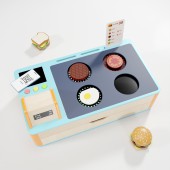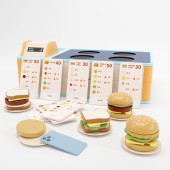DESIGN NAME:
Yummy
PRIMARY FUNCTION:
Toy
INSPIRATION:
Kitchen simulation games have been a huge success on platforms such as computers and mobile phones and have proved to be fun, engaging and popular with children.
Wooden toys have the advantage of being environmentally friendly and safe. In today's society, virtual game simulations are highly enjoyable, but there is still a majority of the parent community that believes: physical toys are better for the healthy development of children.
UNIQUE PROPERTIES / PROJECT DESCRIPTION:
Designed primarily to provide a restaurant simulation play experience for children, the main body contains a teppanyaki oven, a cash register, a set of wooden ingredients and a set of wooden menus.
The toys can be played by more than one person. By playing different roles such as customer and chef, children will learn about the restaurant operation process such as taking orders, cooking, serving and checking out, and develop their hands-on, cognitive and social skills.
OPERATION / FLOW / INTERACTION:
The players take on the roles of the customer and the chef respectively.
Step 1: The customer selects the dish he wants and the menu.
Step 2: The chef finds the appropriate ingredients according to the menu.
Step 3: The toy will identify the ingredients and display the processing progress.
A white light indicates that cooking is in progress.
A green light indicates cooking is complete.
A red light indicates overcooking.
Step 4: When the dish is ready, the customer gives an evaluation and pays the amount.
PROJECT DURATION AND LOCATION:
The project was launched in Ningbo in March 2022, the initial prototype was completed in Hangzhou in July 2022 and is still being optimized.
FITS BEST INTO CATEGORY:
Toys, Games and Hobby Products Design
|
PRODUCTION / REALIZATION TECHNOLOGY:
The design has been functionally tested twice on sample models.
Materials: The wooden part of the prototype is made of linden plywood, including the wooden box, drawers and wooden components; the 'iron plate' part is made of matt acrylic PMMA with light transmission; the button part is 3D printed in resin.
Functional realization: Arduino UNO for data processing, combined with RFID modules and RFID tags for reading and identifying "ingredients" and "menus".
SPECIFICATIONS / TECHNICAL PROPERTIES:
540 x 300 x 205 (W mm x D mm x H mm).
The radius of the ingredient's averages 70mm to prevent accidental swallowing by children.
TAGS:
Children's toys, restaurants, simulations, cooperative games, cognitive exercise, wireless interaction, cooking
RESEARCH ABSTRACT:
This project is a toy product design that attempts to explore the experience and optimisation of a physical multiplayer collaborative toy. A first version of the prototype was implemented using Arduino tools.
The kitchen management game has gained popularity on digital platforms. We tried to make it physical and design it specifically for children.
CHALLENGE:
We tried to implement a cooking simulation using the NFC toolset. However, it was a relatively difficult development process to accurately differentiate the ingredients and to have the NFC module consistently read and represent the corresponding status in real time.
ADDED DATE:
2022-08-27 15:41:34
TEAM MEMBERS (1) :
IMAGE CREDITS:
Hang Li, 2022.
|










